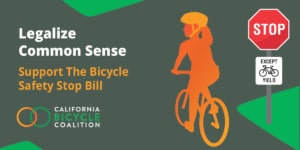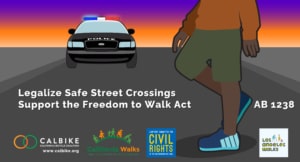Bicycle Safety Stop FAQs
The Bicycle Safety Stop Bill will make it legal for people on bikes to do what they already do: slow at stop signs, stop if necessary, and proceed with care if the way is clear. It’s a commonsense bike riding maneuver that’s legal in several other states. Yet the governor has vetoed it twice, citing safety concerns. So we wanted to break down common misconceptions about the bicycle safety stop to respond to those concerns.
What is the bicycle safety stop?
The bicycle safety stop allows bicycles to treat stop signs as yields. When a bike rider comes to a stop sign, they must slow down and assess whether they have the right of way and whether it is safe to proceed. If the intersection is clear, the person on a bike may proceed. However, bikes still have to yield to pedestrians and other traffic that entered the intersection first.
Is the safety stop the same as the Idaho stop?
Yes and no. The original safety stop law, passed in Idaho in 1982, allows people on bikes to ride through red lights after coming to a full stop, in addition to treating stop signs as yields. So the bicycle safety stop, as proposed in California, resembles half of the Idaho stop law. California would not allow bike riders to treat red lights as stop signs.
Is the safety stop the same as the Delaware yield?
California’s safety stop law would be the same as the Delaware yield, which allows people on bikes to yield at stop signs.
Is the bicycle safety stop legal in California?
No. Assemblymember Tasha Boerner authored a bill to legalize the bicycle safety stop in 2021 and 2022. Both bills passed the Assembly and Senate and were vetoed by Governor Gavin Newsom. The governor cited safety concerns in his veto messages.
In 2023, Boerner is running AB 73 in another attempt to make stop-as-yield legal for adults on bikes in California. As of this writing, it has passed the Assembly and is moving through committees in the Senate soon. Look for opportunities to raise your voice to support AB 73 in the coming months.
Is the bicycle safety stop safe?
In the six years after Delaware legalized stop-as-yield for bikes, the state police have reported that bike-involved crashes went down, most notably at intersections. The National Highway Traffic Safety Administration (NHTSA) issued a fact sheet in 2022, citing the safety of stop-as-yield laws. There is no evidence that the laws have made bicycling less safe anywhere they have been adopted.
Why does CalBike support the bicycle safety stop?
CalBike has long supported legalizing the bicycle safety stop.
- Treating stop signs as yields makes sense for bike riders because it conserves momentum.
- At bike riding speeds and with full visibility (bikes don’t have blind spots), it’s safe for bikes to yield at stop signs when the intersection is clear of other traffic.
- Bike riders are safer when car drivers know what to expect. The safety stop is a common and commonsense behavior that is likely to reduce crashes.
- Most bike riders never get a ticket, despite commonly treating stop signs as yields. However, we know that Black and Latino bike riders in California are targeted by police disproportionately and are more likely to be cited for minor infractions with no impact on public safety, such as rolling through a stop sign. Legalizing the safety stop will reduce the number of traffic stops for people on bikes that can sometimes become deadly police encounters.
What are the benefits of the bicycle safety stop?
The bicycle safety stop gives people in cars better information about what to expect from people on bikes, particularly at intersections. It has been shown to reduce or have no effect on crashes involving bikes. And it will make Black and Latino bike riders safer from pretextual police stops.
The safety stop allows bike riders to conserve momentum and maintain the flow of traffic, making riding more intuitive and fun. And that’s good for the climate and for neighborhood safety because the more people that bike, the safer it is to ride.
Where is the bicycle safety stop legal?
At the moment, some version of the bicycle safety stop is legal in these states:

- Idaho
- Washington
- Oregon
- Utah
- North Dakota
- Oklahoma
- Arkansas
- Delaware
- District of Columbia
- Minnesota (as of 8/1/2023)
Legislation is currently being considered in Virginia, New York, and Texas, and there is interest in other states and in Canada as well.
What’s the federal position on the bicycle safety stop?
The National Highway Traffic Safety Administration (NHTSA), under the auspices of the U.S. Department of Transportation, issued a fact sheet in 2022 citing the safety and benefits of stop-as-yield laws.
Is it dangerous for bikes to treat stop signs as yields?
Legalizing the safety stop is an important step to recognizing that riding a bike is different from operating a motor vehicle and creating bike-specific regulations that make it easier for bike riders to operate legally and safely on California roadways.
The safety stop won’t cause bike riders to suddenly start blowing through stop signs or riding more dangerously. They will do what they currently do: slow down at stop signs, stop when necessary, and ride cautiously through the intersection if the way is clear. The only difference will be that this common, safe way to ride will be legal.
Why did the governor veto the bicycle safety stop before, and why won’t he veto it again?\
In the governor’s veto message, he stated he was concerned that the change in law may decrease rather than increase safety, specifically for children. Ignoring years of data from other states that have successfully implemented the law, he instead focused on faulty state traffic data that effectively blamed people on bikes for increasing collisions. This time around, more states have adopted these laws, and more data is available. In addition, this year’s bill only applies to adults, so we’re hopeful the governor will take a more reasonable position.
People on bikes already do crazy things. Won’t the safety stop make them even more dangerous?
A small minority of bike riders, like a minority of car drivers, make poor choices, disregard the safety of others, and fail to share the road considerately. If you drive a motor vehicle around people biking, you may notice the few who ride unpredictably and not the many who share the road safely and considerately.
So, no, people on bikes don’t generally do crazy things. If a bike rider blows through a stop sign and gets hit by a car, the person on the bike will fare much worse in the collision than the person in the car, so the bicyclist, a vulnerable road user, has a strong incentive to be cautious.
Unfortunately, our streets and roads were designed for people in cars. Bike riders do their best to find safe ways to get where they need to go, often without safe or adequate infrastructure. That can lead to confusion and challenges in sharing the road.
People on bikes aren’t the only ones who treat stop signs as yields on California roads. Our state is famous for the California rolling stop, where a car driver slows but doesn’t stop at a stop sign. Perhaps you do this yourself.
If someone in a 2-ton vehicle with limited visibility can safely roll through a stop sign, someone on a human-powered, low-speed, 30-pound bicycle (or even a slightly heavier and faster e-bike) with a tall vantage point and high visibility can certainly do the same.
Everyone will be safer if we make the bicycle safety stop legal. If you support the Bicycle Safety Stop Bill, sign our petition and stay tuned for chances to tell the decision-makers in Sacramento that California should legalize stop-as-yield for people on bikes.





